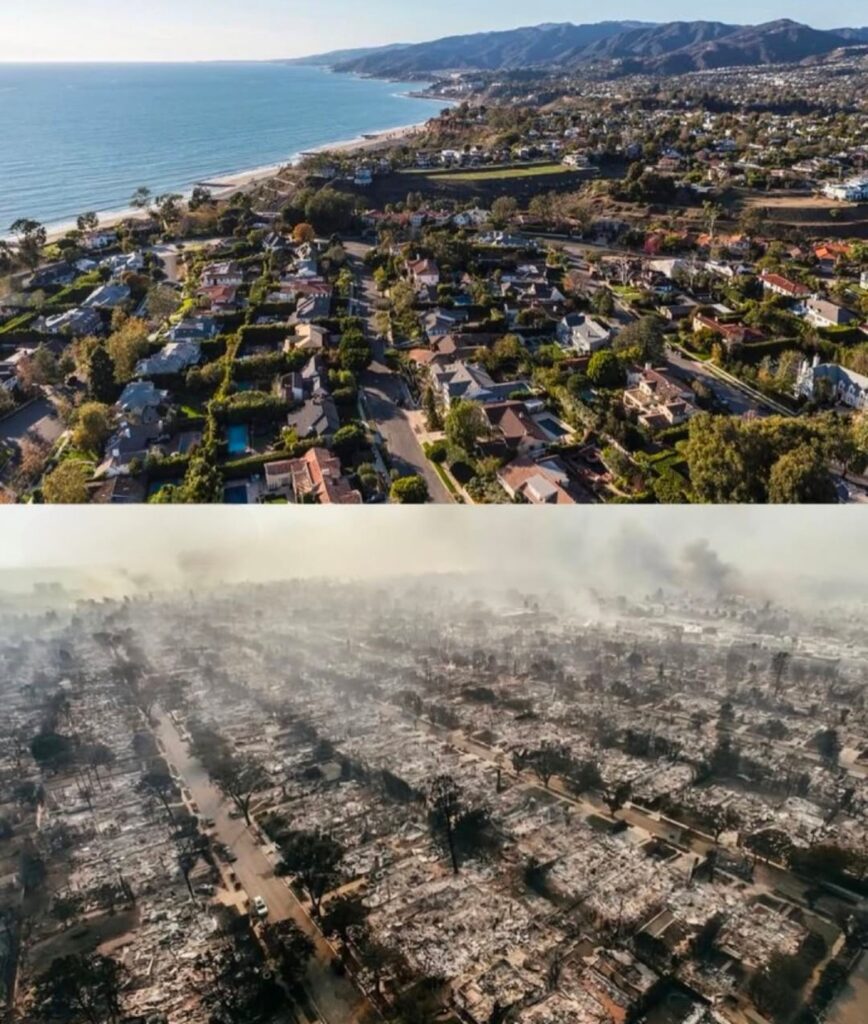
Devastating Wildfires in California: The wildfires that have spread across #California’s forests have inflicted severe damage, particularly in Los Angeles. This disaster has claimed the lives of at least 24 people, and many others are still missing. Over 12,000 buildings, including residential homes, apartments, and some commercial structures, have been destroyed by the fire.
Efforts to Control the Fire: Firefighters are battling to contain the blaze, but as of now, they have not been successful in bringing it under control. The fire continues to rage, and its destructive path has forced millions of residents to evacuate their homes. Hollywood Hills, an area home to many celebrities, has also been affected by the fire.
Potential for Further Destruction: With the threat of strong winds in the area, the fire could potentially spread to other landmarks, including the J. Paul Getty Museum and the University of California. There are growing concerns that the death toll may rise, and the cold weather in the U.S. has not been enough to slow the fire’s progress.
Economic Losses: The wildfires have caused an estimated loss between $135 billion and $150 billion. In addition to U.S. firefighting resources, teams from Mexico and Canada have arrived to assist in controlling the fire, but so far, the situation has not improved. The fire shows no signs of subsiding.
Firefighting Assistance from Neighboring Countries: Firefighters from Mexico and Canada have sent resources to help fight the fire in the U.S. This collaboration is a reciprocal effort, as the U.S. had assisted Canada during its own wildfire crisis in 2023. However, the intense firefighting efforts have depleted large quantities of water, causing concern about the long-term effects on local water sources.
Water Depletion and Drought Conditions: Excessive water usage in firefighting operations has led to the drying up of approximately 20% of lakes in the affected areas. This could result in worsening drought conditions in the future, further complicating the efforts to manage the fire and causing additional environmental challenges.
Impact on Celebrities and Officials: High-profile figures, including Paris Hilton, Tom Hanks, and Steven Spielberg, have had their homes destroyed. The home of Vice President Kamala Harris has also been evacuated due to the fire. The extent of the damage highlights the scale of this disaster, which is now considered the largest wildfire in U.S. history.
Power Outages and Spread of the Fire: Around 70,000 people in #California were without power due to the fire. Although winds had calmed during the day, they picked up again at night, causing the fire to spread to an additional 1,000 acres in the last 24 hours. Weather forecasts predict that wind speeds will increase in the coming days, making it harder to control the fire.
The Role of Santa Ana Winds: The Santa Ana winds, which can reach speeds of up to 120 km/h, are a major factor contributing to the fire’s rapid spread. Videos showing the fire’s progress reveal that the winds have been fanning the flames, making firefighting efforts more difficult. The strong winds have exacerbated the fire’s intensity, particularly in urban areas.
A War-like Situation: U.S. President Joe Biden has likened the situation to a war, as efforts to control the fire face numerous obstacles. In addition to the fire itself, looting has become a significant problem in the evacuated areas. To prevent further chaos, a communication curfew has been imposed, and law enforcement has made several arrests in connection to looting attempts.
Challenges Faced by Firefighting Teams: Despite the involvement of thousands of firefighters, the fire has continued to burn for six days without being brought under control. Cold temperatures, a lack of sufficient rainfall over the past decade, and strong winds have all contributed to the fire’s rapid spread. Global warming is also considered a contributing factor, with 2024 projected to be the hottest year on record.
Cause of the Fire: Initially, there were reports suggesting that the fire might have been intentionally set. However, Los Angeles fire officials have since dismissed these claims, stating that there is no evidence of arson. The fire likely started in a forested area, fueled by dry vegetation and dead trees that facilitated its rapid spread.
Vegetation and Drought Conditions: California’s natural environment has played a significant role in the fire’s rapid spread. The region’s mountainous terrain is covered with pine forests, which have a lot of dry, dead trees. This dry vegetation, coupled with strong winds, has allowed the fire to quickly escalate. The lack of significant rainfall in recent years has further contributed to the dry conditions.
Impact of Last Year’s Weather: The 2022-2023 period was the wettest in California’s history, which led to an abundance of vegetation growth. However, the following year saw a drastic reduction in rainfall, creating an ideal environment for wildfires. Additionally, dry winds from October onwards have only worsened the situation.
The Ongoing Battle with the Fire: Despite all efforts, the fire continues to burn uncontrollably, and no rain is expected in the next week. The presence of strong winds on the day the fire started further hampered firefighting efforts, as emergency responders struggled to reach the affected areas.
Urban Density and Limited Resources: California’s densely populated urban areas, especially in cities like Los Angeles, have made firefighting efforts more difficult. The narrow, crowded streets and limited access to some areas have slowed down the response time, allowing the fire to spread even further.
Multiple Fire Outbreaks: Another challenge has been the simultaneous outbreak of multiple fires. Instead of being contained to one location, the fire ignited in four different places, overwhelming the firefighting teams. This situation mirrors the challenges faced during a similar wildfire outbreak in 2018, highlighting the ongoing struggle to prevent and manage large-scale fires.
The Need for Preparedness: Despite preparations made in response to past wildfires, the sheer scale of this event caught authorities off guard. The multiple fire outbreaks and the intensity of the wind have left emergency responders with limited capacity to control the situation.
The Aftermath and Continuing Challenges: The devastating impact of the fire is still being felt, with thousands of homes destroyed, significant economic losses, and the ongoing threat of further spread. The firefighters and emergency responders continue to work tirelessly, but the challenges they face remain daunting.
Call for Action: This disaster serves as a stark reminder of the need for better preparedness, stronger environmental policies, and greater global cooperation to address climate change. While efforts are being made to control the fire, its aftermath will likely continue to impact California and the U.S. for years to come.


